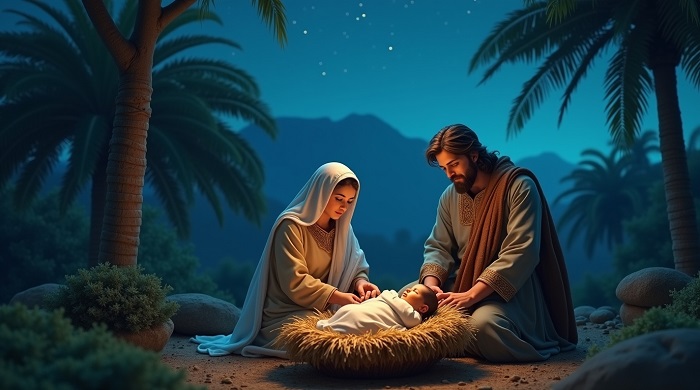The word “Nativität” carries a powerful resonance that goes beyond its simple translation as “Nativity.” It represents the essence of birth, origin, and the divine manifestation of life. Across history, philosophy, art, and religion, Nativität has held a sacred place as a symbol of creation, purity, and spiritual renewal. This concept has guided generations in their understanding of existence, influencing traditions, celebrations, and expressions of faith in different cultures. To truly understand Nativität, one must explore not just its linguistic meaning but also the depth of its historical, religious, and artistic presence.
Understanding the Essence of Nativität
At its core, Nativität means the act of being born, the emergence of life into the world. In religious contexts, it particularly refers to the birth of Jesus Christ a divine moment that marks the foundation of the Christian faith. However, beyond the boundaries of religion, Nativität represents something universal the miracle of life itself. It speaks to the human experience of beginnings, the sacred energy of creation, and the eternal cycle of existence.
The beauty of Nativität lies in its dual nature. It is both human and divine, physical and spiritual. When one reflects on this word, it evokes not just the image of a birth scene, but also the emotional and metaphysical transformation associated with new life. It carries a message of hope, renewal, and continuity. Every culture, in some form, recognizes this divine spark the moment when the unseen becomes seen, when potential becomes reality.

Historical Context and the Evolution of Nativität
The concept of Nativität has ancient roots that can be traced back to early civilizations that celebrated birth as a sacred act. In Christian history, the Nativity of Jesus became a defining moment that changed the world’s spiritual direction. From the earliest days of Christianity, depictions of the Nativity were used to teach faith, convey divine mysteries, and remind believers of the humility of God made human.
In medieval Europe, the word “Nativität” took on strong artistic and theological significance. It became central to the calendar of feasts and was celebrated not only as a religious observance but also as a communal and cultural event. Artists, poets, and theologians found endless inspiration in this theme, giving rise to paintings, sculptures, and hymns that conveyed the deep emotion of the divine birth.
Over centuries, Nativität evolved beyond its initial Christian meaning. It began to represent the broader concept of beginnings of spiritual awakening, of rebirth, of the continuous creation that exists in the universe. Even in secular art and literature, Nativität appears as a metaphor for the dawn of new ideas, the birth of nations, or the awakening of the soul.
The Religious Symbolism of Nativität
Religiously, Nativität holds one of the most profound places in Christian theology. The Nativity of Christ symbolizes the incarnation of God a divine being choosing to experience human life. This moment represents the merging of heaven and earth, the embodiment of divine love, and the promise of salvation. The story, filled with humility and grace, speaks to the spiritual connection between the divine and the mortal.
In Christianity, the celebration of the Nativity is not merely about the physical birth of Jesus but the beginning of redemption and the light entering a world of darkness. Every symbol in the Nativity story from the manger to the star, from the shepherds to the angels carries spiritual depth. The manger represents simplicity and humility, the star symbolizes divine guidance, and the shepherds signify humanity’s openness to faith. Together, they create a scene that encapsulates the beauty of divine manifestation in the most ordinary circumstances.
Nativität in Art and Culture
Art has always been one of the most powerful ways to express Nativität. From the earliest Christian frescoes in catacombs to Renaissance masterpieces, the Nativity scene has remained a timeless subject of inspiration. Each era reinterpreted Nativität through its own cultural and artistic lens, yet the emotion remained consistent the awe of witnessing divine birth.
In the works of artists like Giotto, Botticelli, and Caravaggio, the Nativität scene transcends simple illustration. It becomes a dialogue between light and darkness, between heaven and earth. The soft light illuminating the infant Christ, the expressions of wonder on the faces of Mary and Joseph, and the reverence of those gathered create an atmosphere filled with both serenity and revelation.
Even outside traditional religious art, Nativität finds representation in literature, music, and theater. The themes of birth, new beginnings, and divine presence appear in countless cultural works. Whether through the gentle rhythm of a Christmas carol or the grand emotion of a Renaissance painting, Nativität continues to inspire creativity that connects humanity with its sense of origin and purpose.
The Spiritual and Philosophical Dimensions of Nativität
Philosophically, Nativität is not limited to the act of birth but extends to the concept of becoming the process by which existence unfolds and meaning takes form. It symbolizes the eternal beginning that exists within every moment, suggesting that life is a continuous act of creation. The divine birth is not just an event that happened once in history; it is an ongoing experience reflected in every transformation and renewal within the human soul.
Thinkers and mystics throughout time have used Nativität as a metaphor for enlightenment, awakening, and the realization of truth. To be “born” in this sense is to discover one’s true nature, to awaken to divine consciousness. Thus, the Nativität is both a story of divine incarnation and an allegory for spiritual rebirth within every individual.
Cultural Celebrations of Nativität
Throughout the world, the celebration of the Nativity or Nativität has developed into one of the most beloved traditions. Christmas, derived from this sacred event, has grown into a global celebration that unites faith, culture, and family. Yet beyond the decorations and festivities, the true essence of Nativität lies in reflection and gratitude for the gift of life.
In various regions, cultural expressions of Nativität take unique forms. From elaborate crèches and live reenactments in Europe to spiritual songs and midnight prayers across Latin America, each culture embraces Nativität as both a religious observance and a communal moment of togetherness. The universal language of birth and renewal allows this celebration to transcend boundaries, touching the hearts of people regardless of language or background.
The Influence of Nativität in Modern Society
In modern times, the concept of Nativität continues to hold deep meaning, even as societies evolve and secularize. The imagery and message of birth, renewal, and light remain relevant in contemporary culture. Artists, filmmakers, and writers still draw from this sacred theme to express transformation, purity, and hope.
Furthermore, Nativität serves as a reminder of humanity’s need for connection, compassion, and humility. In a world often defined by technology and materialism, the message of the Nativity story brings balance. It calls for the recognition of what is truly valuable love, kindness, and the miracle of life itself. The enduring appeal of Nativität proves that even in modernity, the human soul continues to seek the divine origin from which it came.
Symbolic Meaning of Birth and Renewal in Nativität
The word Nativität carries within it the eternal symbolism of new beginnings. Every birth physical or spiritual represents a moment of transformation. It is a passage from darkness to light, from potential to realization. In religious imagery, this is portrayed through the birth of Christ, who represents divine light entering the world. But beyond this, it mirrors the inner journey of every individual seeking truth and purpose.
The symbolism of Nativität extends into nature, where every dawn is a reminder of life’s ongoing renewal. The cycle of seasons, the blooming of flowers, and the rhythm of time itself are reflections of the same divine principle — that life continually gives birth to itself. To embrace Nativität is to recognize this sacred rhythm in all existence, to see the divine hand in every beginning.
Nativität as an Inspiration for Humanity
One of the most profound impacts of Nativität is its power to inspire human goodness. The story of divine birth set in simplicity teaches humility, compassion, and faith. It shows that greatness can emerge from the most modest circumstances and that light often shines brightest in darkness. Throughout history, this message has inspired acts of kindness, creativity, and transformation.
Nativität encourages people to rediscover their inner purity and to act from love rather than ego. It is a reminder that within every human heart lies the potential for rebirth to begin again, to forgive, and to live with renewed purpose. This timeless inspiration is what makes Nativität not just a historical or religious event, but a living philosophy that continues to shape lives.
Nativität in Literature and Symbolic Language
Writers and poets have often turned to the imagery of Nativität to express profound truths about life and the human condition. Whether in medieval hymns or modern poetry, the motif of divine birth symbolizes revelation, transformation, and hope. The language of Nativität is rich with metaphor light breaking through darkness, innocence emerging amidst chaos, and the quiet beauty of divine presence.
This literary use of Nativität allows the concept to move beyond theology into the realm of universal wisdom. It speaks to the inner longing for renewal that exists within every human being. The act of creation, whether it be artistic or spiritual, mirrors the original Nativität the moment when life and meaning come into being.
The Enduring Power of Nativität
Even after centuries, Nativität continues to be one of the most powerful symbols in human consciousness. Its endurance lies in its simplicity the image of a child born in humble surroundings and in its depth the representation of divine manifestation in human form. It connects the sacred with the everyday, teaching that the divine can be found not only in temples or heavens but within the smallest, purest expressions of life.
The enduring power of Nativität lies also in its universality. Every person, regardless of faith or culture, can relate to the theme of birth and renewal. It is a story that transcends doctrine, touching the very essence of what it means to exist. In this way, Nativität becomes more than a Christian narrative; it becomes a human truth — the celebration of life itself.
Conclusion: The Eternal Message of Nativität
Nativität stands as a timeless reminder of life’s sacred origin and the divine mystery that surrounds every beginning. It tells of the beauty of humility, the power of love, and the eternal cycle of renewal. Whether viewed through the lens of religion, art, or philosophy, Nativität represents the spark that connects humanity with the divine source of all creation.
In a world constantly seeking meaning, Nativität offers a gentle but profound truth that every birth is holy, every new beginning carries divine purpose, and within every heart lies the possibility of spiritual rebirth. To understand Nativität is to recognize the sacred rhythm of life, where every ending leads to a new dawn and every soul is a reflection of the divine light.
FAQs About Nativität
What does the term Nativität mean?
Nativität means “Nativity” in English, referring to birth, especially the divine birth of Jesus Christ. It also symbolizes new beginnings and the sacred act of creation.
Why is Nativität significant in Christianity?
It represents the birth of Jesus, marking the incarnation of God in human form and the beginning of salvation and divine love.
How is Nativität celebrated around the world?
It is mainly celebrated through Christmas traditions, prayers, Nativity scenes, music, and acts of charity reflecting divine love.
What does Nativität symbolize beyond religion?
It symbolizes renewal, hope, and the creative energy of life, inspiring art, literature, and personal transformation.
Why does Nativität remain important today?
It continues to remind humanity of humility, compassion, and the sacred nature of every beginning, keeping faith and hope alive across generations.



